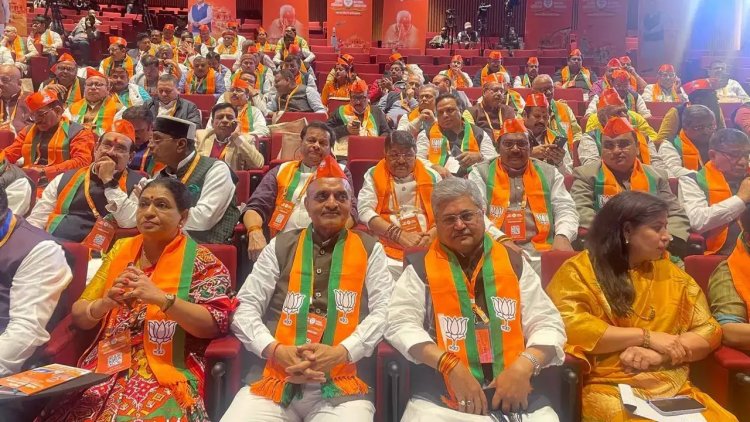BJP’s National Council Meet: Party in Combat Mode for 2024 General Elections
Asia News Agency

The National Council of the BJP met in Delhi on February 17 and 18 setting the tone for the party’s Lok Sabha election campaign. Prime Minister Narendra Modi set the party a target of winning 370 seats in the Lok Sabha, compared to the 303 seats that it had won in the 2019 general election. The symbolism of the number, writes The Hindu “is about Article 370, which his government invalidated in fulfilment of a fundamental principle of the party.” Article 370 that provided a notion of autonomy to Jammu and Kashmir, and the construction of the Ram temple in Ayodhya “were two of the three issues that have propelled the BJP’s rise.” Having fulfilled them during his second term, PM Modi has staked claim to a third. In fact, he has raised the stakes by setting a higher target of 370 seats and an additional 370 votes in every polling booth which, if met, can raise the party’s voteshare above 50%.
The BJP will also focus on converting the raft of welfare measures that it has either launched or repurposed into votes. Alongside revving up its organisational engine, the BJP is also seeking to expand its footprint by the continuous induction of leaders from other political parties on the one hand, and tying up alliances with regional parties on the other.
Opportunistic alliances
Meanwhile, Union Home Minster Amit Shah’s attacks on the Opposition at the National Council meeting, on the question of corruption and dynastic succession, indicated that the party will remain in offensive mode in the run-up to the general election. Its opportunistic alliances with leaders and parties that it has accused of corruption, writes The Hindu “are shrouded by claims of good governance and transparency. The BJP manages to pull off this feat by wrapping its claims in strong communal identity terms. A resolution passed by the Council hailed the Ayodhya temple as a manifestation of Ram Rajya, an ideal type of just and fair governance. The party is trying to mobilise Hindu solidarity around the temple, and simultaneously present it as an emblem of a non-sectarian national agenda of development and progress. It is a hard act, but the BJP seems to manage this by keeping itself constantly in combat mode.”
7 takeaways
At the deliberations at the two-day national convention of the BJP that concluded last week, DK Singh (ThePrint’s Political Editor) notes that one leader after another were “singing paeans to Prime Minister Narendra Modi, resolutions showering praise on him, the PM’s name figuring 84 times in the 11-page political resolution, and deafening Modi-Modi chants. Nothing new…”
Besides this, Singh identifies seven takeaways from the speeches delivered and the resolutions passed at the national convention.
Subramanian Swamy’s attack: First, “BJP leader Subramanian Swamy had the mighty high command on the backfoot. He had threatened to take legal action against the party on ‘the lack of internal party elections as violative of statutory and constitutional provisions’ and the extension of BJP president JP Nadda’s term in contravention to the party constitution….”
BJP strategy - Modi, Ram, and Rahul Gandhi: Second, “the resolutions and the speeches at the convention highlighted the three prongs of the BJP’s campaign strategy for the 2024 Lok Sabha election — Modi, Ram, and Rahul Gandhi.”
The three resolutions were on: ‘Viksit Bharat’ (Developed India), Modi’s Guarantee (BJP- Country’s Hope, Opposition’s Despondency); and the Ram Mandir. In a similar exercise in January 2019, ahead of the Lok Sabha elections, BJP’s national council had passed two resolutions — on the welfare of the poor and agriculture. “The shift in the BJP’s strategy is obvious: From Modi and agriculture and to Modi and Ram.”
Cultural renaissance and civilisational pride: Third, “the latest resolutions mark another shift — from the BJP’s claims of undoing the wrongs of the Congress governments in the past 70 years to taking people into a new era….in which cultural renaissance and civilisational pride must get primacy over immediate temporal, mundane concerns. The day of the consecration of Ram Lalla in the Ayodhya Temple — 22 January 2024 — was the ‘renaissance of India’s spiritual consciousness and the beginning of the journey back to great India’.”
The resolution also said that India will become a $5 trillion economy by 2027.
Silence on farmers’ welfare: Fourth, after the temple, the BJP can now let go of smaller, temporal things. Surprisingly, the BJP’s new resolutions are silent on this issue — only a single paragraph talks about ‘farmers’ welfare’, with no mention of doubling their income or the Swaminathan Commission.
Attack on dynasts: Fifth, notes Singh “the BJP still finds juice in the opposition’s dynastic politics, no matter how many dynasts it has inducted—the latest being former Maharashtra chief minister Ashok Chavan, son of ex-CM Shankarrao Chavan….
“While the party’s targeting of dynasts is an old strategy, what’s interesting is how Shah chose seven of them—Congress, Nationalist Congress Party, Shiv Sena, Samajwadi Party, Trinamool Congress, Rashtriya Janata Dal, and the Dravida Munnetra Kazhagham. This fits into PM Modi’s revised stance on dynasties — dynasts are okay, but dynastic parties are a threat to democracy.”
Corruption: Sixth, India Today’s latest Mood of the Nation survey indicated that the country is divided over whether or not the Modi-led government has reduced corruption, with 46 per cent of the respondents saying ‘yes’ and 47 per cent saying ‘no’.
“But the BJP’s resolutions suggest that it is convinced that corruption charges against opposition leaders still work electorally….”
Concern over bringing down elected governments to usurp power: Seventh, “BJP’s resolutions reflected concern regarding the growing perception that the party is bringing down elected governments to usurp power. Or so it seems from the concerted attack on the Congress for destabilising governments in the past……The resolution on the opposition also cited the imposition of the Emergency in this context….”
















